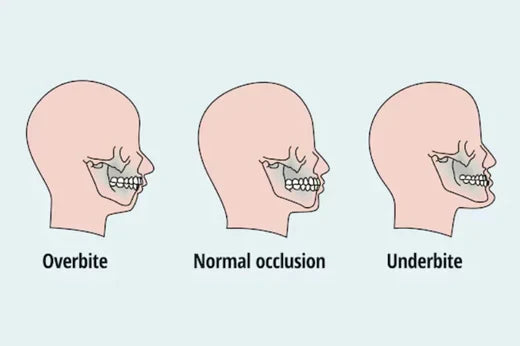
Table of contents
- What Is a Normal Bite?
- What Is an Overbite?
- What Is an Underbite?
- Overbite vs Underbite: Key Differences
- The Consequences of Untreated Overbite or Underbite
- Treatment Options for Overbite and Underbite
- The ALIGNERCO Advantage for Overbite and Underbite
- Conclusion
- FAQs
Concerning dental and occlusal alignments, words such as overbite, and underbite, are often used in conversations about oral health and esthetics. Both of these conditions are characterized by gross dental and jaw misalignment that can impact the appearance, voice, and general well-being of an individual. An understanding of the difference between an overbite and an underbite is crucial to determine what solution best applies, especially considering contemporary, non-invasive options e.g. ALIGNERCO clear aligners.
In this blog, we’ll dive into the causes, symptoms, and treatment options for these dental conditions, helping you make informed decisions for a healthier, more confident smile.
What Is A Normal Bite?

To understand the contrast between normal bite vs overbite or underbite, let’s start with the basics. A "normal bite" is when the upper front teeth slightly overlap the lower front teeth, and the molars fit together in a balanced manner. This ideal alignment enables proper chewing, speaking, and smiling. If this alignment is disturbed, it can lead to impairment in activities of daily living, such as eating or talking.
Variations from it are classified as malocclusions, which are also overbite and underbite. These discrepancies are not only aesthetic matters—they can also result in functional impairment if ignored.
What Is An Overbite?

An overbite is a situation when the teeth of the upper front segment are protruding adequately, overlapping the teeth of the lower front segment and, generally, the distance between teeth is measured vertically. A slight overlap (approximately 2-4 mm) is considered normal. But if the overlap extends outside this range, it becomes a nuisance. Overbites can be particularly noticeable when a person smiles or speaks, potentially affecting their confidence.
Types of Overbites
Dental Overbite
This occurs due to improper alignment of the teeth, rather than issues with the jaw itself. The teeth can move because of overocclusion or malocclusion during growth.
Skeletal Overbite
This occurs when there are discrepancies in jawbone development, such as an overdeveloped upper jaw or underdeveloped lower jaw. These jaw problems could necessitate higher level therapies including surgery or orthodontic correction.
Signs and Symptoms of an Overbite
- Night grinding or clenching can cause pain or damage to the teeth.
- Jaw pain or discomfort, particularly when chewing or speaking.
- Such a short or "gummy" smile results from the upper set of teeth covering the lower teeth excessively.
- Higher mechanical wear of the lower teeth may impinge on the subsequent dental issues.
Common Causes of Overbite
Genetics: Heritability is an important factor in jaw size and morphology. If a parent or sibling has an overbite, there is a higher chance of developing the condition.
Childhood Habits: Extended thumb-sucking, nail-biting, or pacifier use during early childhood can protract the upper teeth forward and cause an overbite.
Jaw Growth Issues: Uneven development of the upper and lower cranial bones can lead to overbite. This could be further worsened by habits/environmental factors during childhood.
Tooth Eruption Problems: Misaligned or overcrowded teeth during childhood can result in an overbite. Deviated teeth eruption may result in a chain reaction of dental malocclusion.
What Is an Underbite?

An underbite is when lower teeth tend to project beyond the upper teeth, resulting in a protrusion in the jaw. This disorder, also known as prognathism or Class III malocclusion, may lead to substantial functional problems on top of its aesthetic effect. People with an underbite often experience difficulty in chewing, speaking, and even breathing, as the jaw may be positioned abnormally.
Signs and Symptoms of an Underbite
- The inability to bite or chew food, especially when attempting to take food requires a lot of jaw movement.
- An out-turned lower jaw changes facial profile and produces appearance anxieties and compromised self-image.
- Speech sound disorders, specifically the so-called S and Z sounds, can be muffled or unclear.
- Chronic jaw pain and/or clicking sounds in the temporomandibular joint can cause more problems if left untreated.
Common Causes of Underbite
Genetics: Just as overbites, underbites are also typically in heritability from one or both parents. Genetic factors contribute significantly to jaw alignment and structure.
Childhood Habits: Habits of tongue thrust and thumb sucking may result in an undershot bite. These behaviors put a strain on the teeth and on the jaw during the sensitive periods of tooth and jaw development.
Jawbone Irregularities: Obstruction of the lower jaw, or underdevelopment of upper jaw is a leading cause of the underbite. These bone growth abnormalities may be present at birth or may develop at a later stage of life.
Injuries or Trauma: Jaw structure injuries causing an underbite can occur. Fractured bone or displaced enamel as a result of trauma may require advanced treatment approaches (e.g.)
Overbite vs Underbite: Key Differences
While both overbite and underbite teeth misalignments fall under the umbrella of malocclusions, they differ in their characteristics and impact. The ability to identify these variations can assist patients in tailoring treatments based on individual requirements.
| Feature | Overbite | Underbite |
|---|---|---|
| Appearance | Upper teeth significantly overlap lower teeth | Lower teeth extend beyond upper teeth |
| Primary Cause | Genetics, thumb-sucking, grinding | Genetics, jaw misalignment, injury |
| Complications | Tooth wear, jaw discomfort | Speech issues, TMJ pain, dental hygiene challenges |
Functional impairment associated with the two conditions highlights the need for early diagnosis and acute treatment.
The Consequences of Untreated Overbite or Underbite
Leaving an overbite or underbite untreated can lead to several complications.
Jaw Pain
Uneven occlusion exerts an excessive load on the jaw joints and the musculature of the jaw, with the possibility of developing chronic pain, or temporomandibular joint (TMJ) disorders. This can make eating, speaking, and even resting uncomfortable.
Excessive Tooth Wear
Misalignment can load teeth unevenly, resulting in fractures, cracks, or enamel loss. In the most extreme cases, teeth can become exposed to acid decay or even be lost.
Speech Issues
In severe malocclusions, the tongue position can be changed, thus creating a problem for producing certain speech sounds. For example, individuals with underbite might have difficulty perceiving the sounds "s," "z," and "sh.
Oral Hygiene Challenges
Crowded or malpositioned teeth are difficult to clean, which elevates the risk for caries and periodontitis. Out-of-kilter dentition may reduce the efficacy of tooth brushing and flossing, allowing plaque and bacteria to accumulate.
Low Self-Esteem
Aesthetic concerns associated with overbites and underbites can significantly impact confidence and mental health. People suffering from these conditions often have a poor self-image to the point of social anxiety or diminished quality of life.
Treatment Options for Overbite and Underbite
Contemporary orthodontic innovations provide a variety of options for overbite vs. underbite malocclusion. The therapy selected usually depends on clinical severity, patient age, and also a decision to personalize the therapy.
Conventional Braces
Metal braces have always been an effective solution for the last several decades, based on brackets and wires to shift cavitated teeth position gradually. Despite their effectiveness, they are less esthetic and can be uncomfortable for certain patients and need to be maintained regularly and orthodontist visits need to be made periodically.
Orthognathic Surgery
For severe cases of overbite or underbite caused by jawbone discrepancies, surgical intervention may be necessary. In this technique, the jawbone is deformed to orient it better. Orthognathic surgery is usually limited to adults with mature jaw morphology and extreme malocclusion.
Retainers
In cases of minor misalignments, retainers can help maintain or slightly adjust tooth positioning. Retention is frequently employed following primary treatment to obtain long-term outcomes and prevent teeth from migrating into their former location.
Clear Aligners
Clear aligners can be an excellent choice for mild to moderate teeth misalignment. These custom-made, removable aligners gradually shift the teeth into the desired position without the discomfort and visibility of traditional braces.
The ALIGNERCO Advantage for Overbite and Underbite

ALIGNERCO is a pioneer in offering high-quality but inexpensive clear aligner technologies. Whether you’re dealing with an overbite or underbite teeth, ALIGNERCO offers customized treatment plans that fit seamlessly into your lifestyle.
Key Benefits of ALIGNERCO Clear Aligners: Key Benefits of ALIGNERCO Clear Aligners:
Customized Fit: Tailored aligners designed for your unique dental needs.
Ease of Use: Aligners are removable for eating, drinking, and oral hygiene.
Remote Monitoring: Progress is tracked without frequent in-office visits.
Affordable Pricing: ALIGNERCO aligners are low-cost, facilitating the provision of high-quality orthodontic treatment to a wider population.
With ALIGNERCO you can get a neat, straight, healthy smile, without any pain of ordinary braces. Get in touch with them today to learn how clear aligners can correct your overbite/underbite as well as enhance your quality of life.
Conclusion
It's fundamental for people interested in improving their oral health and appearance to grasp the distinctions between an overbite and an underbite as well as their treatment approaches. Both conditions can cause pain, function, and permanent dental compromise if left unaddressed. Fortunately, modern orthodontic treatments like ALIGNERCO clear aligners offer a discreet, comfortable, and affordable way to achieve the smile you’ve always wanted.
If you’re considering treatment for overbite or underbite, ALIGNERCO is here to help. Discuss their portfolio of clear aligners and begin your path towards a better, more confident smile today.
FAQs
1. Is an overbite or underbite linked to chronic health problems when untreated?
Yes, untreated overbites or underbites can cause jaw pain, TMJ disorders, chewing difficulties, speech issues, and uneven tooth wear. Such problems may also result in gum disease and diminished self-confidence. Early treatment helps avoid these complications.
2. Are overbites or underbites hereditary?
Overbites and underbites are typically heritable conditions, as jaw width and morphology are determined by genetics. In addition, habitually thumb-sucking or pacifier dependence in childhood may also play a role in these disorders.
3. At what age should overbites or underbites be treated?
The best response for the patient is achieved during the age range between 7 and 12 years, while the patient's mandible continues to grow. Adults can also present for treatment but intensive or extended medical care might be needed depending on the severity or additional surgery.
4. How do I know if I need treatment for an overbite or underbite?
When biting, chewing, or substantial jaw or dental misalignment presents a problem, then treatment may be required. Confirmation of the diagnosis by a dentist or orthodontist may be made and treatment options discussed.
5. Are clear aligners effective for severe overbite or underbite?
Clear aligners are effective for mild to moderate cases. For patients with severe jaw malposition, braces or surgery is necessary. Commission a specialist to determine if ALIGNERCO's aligners meet your requirements.



